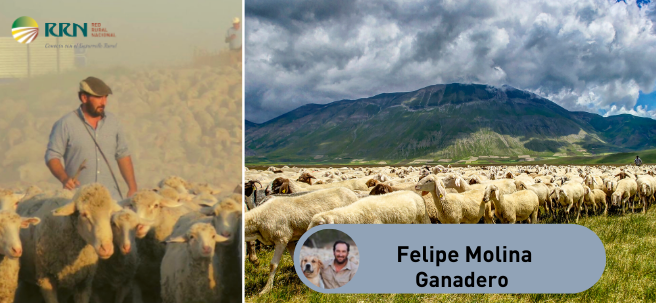
03 de July de 2020
Cambio climático y gestión de recursos naturales
07/03/2020 •Livestock farmer Felipe Molina speaks with the National Rural Network about the art of transhumance, an ancient livestock farming activity that is a candidate for UNESCO World Heritage status.
Transhumance has been declared a "Representative Manifestation of Intangible Cultural Heritage" at the national level since 2017. Italy, Austria and Greece have proposed to UNESCO that it be considered " Intangible Cultural Heritage " by symbolically representing a way of life that is expressed through a sustainable relationship between humans and nature.
Transhumance is a form of pastoralism based on the seasonal migration of people and their livestock. This recurring migration can vary in distance and takes place between regions with different climatic conditions. By following livestock routes , transhumants provide their livestock with quality pastures year-round. In addition to ensuring the animals receive the best possible food, it also prevents overexploitation of the area's resources.
Felipe Molina (Córdoba), a biologist by training and a livestock farmer by profession, collaborates closely with the University of Córdoba and its research group on the multiple benefits that the practice of transhumance , which is the form of short transhumance , brings to livestock farming and the environment.
RRN: Why does transhumance mitigate climate change?
Felipe Molina: Rather than mitigating it, it helps us adapt to it. As a biologist, I believe that we can't fight the climate, but we can develop the skills and abilities to adapt to this change. And in the case of traditional extensive transhumance , compared to intensive livestock farming carried out in warehouses, since it is practiced in open fields 24 hours a day, 365 days a year, it modifies the relationship with the environment and nature in a very positive way.
RRN: What specific benefits are we talking about?
F: In our case, they are reflected in the conservation of the dehesa , which is the basis of extensive livestock farming. The plants available for grazing in the dehesa create a layer of vegetation that protects the soil and contributes to CO2 reduction. If there were no grazing, weeds would spread, but transhumance maintains a carpet of vegetation that captures CO2. Furthermore, the seeds deposited under this carpet of grass for livestock later bear fruit again. Likewise, extensive livestock farming does not deplete aquifers and respects the holm oaks for the well-being of the animals.
RRN: What type of transhumance does your livestock practice?
F: Transhumance , which is a type of short-term transhumance and is ultimately the one that survives in Spain. They are short because they cover only a few kilometers and usually take place in fields within the same province.
RRN: How has the COVID-19 pandemic affected your business this year?
F: This year, many colleagues have traveled by truck to avoid passing through infected areas. And we've especially noticed this in the sale of livestock. Our sector depends on the restaurant industry, so the opening of these establishments depends on how we're doing. I always say that lamb is a social meat, a social meal. It requires good conversation and peace in the restaurant. It's a product that's rarely consumed at home. And with the new time-limit regulations in bars, people are eating faster because they have to make way for the next shift, so lamb is being greatly affected.
RRN: How do you view the generational change in the transhumant livestock sector?
F: Difficult. I think it's a very beautiful profession, even if it's hard, and that young people would cope well with it if they had a good salary behind them. In Córdoba, 50 farms used to practice transhumance. Today, only five farms remain.
RRN: What's a day's journey like for a transhumant? What can you tell us about the round trip you undertake?
F: Transhumance is very beautiful along the way, although it's harder once we're settled. When I leave the farm, I'm often accompanied by university students, parents with their children, and even journalists. About 30-40 of us set out, but only for a few kilometers. Once we're settled, there are only three of us left for 2,000 sheep. We take turns watching them for 24 hours. Nowadays, there are no longer any farms or people living there for us to settle in, so we rent the farmhouses, which have electricity, water, and air conditioning. On our journey, we usually pass by 10 different farms. And we always take a portable corral from farm to farm. Our transhumance period is four months . What I do know is that transhumance is very vocational and, moreover, it's always carried out with the well-being of the animals in mind.









